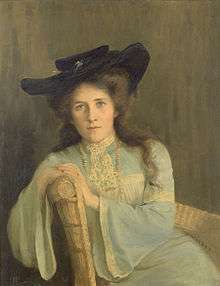Deborah Vernon Hackett
| Deborah Vernon Hackett | |
|---|---|
 A portrait of Lady Hackett, painted by Florence Fuller in 1908 | |
| Born |
Deborah Vernon Drake-Brockman 18 June 1887 West Guildford, Western Australia |
| Died |
16 April 1965 (aged 77) Kilsyth, Victoria |
| Nationality | Australian |
| Other names |
Lady Hackett Lady Moulden Dr Buller Murphy |
| Occupation | Philanthropist |
Deborah Vernon Buller Murphy (née Drake-Brockman, previously Hackett and Moulden; 18 June 1887 – 16 April 1965), best known as Lady Hackett or Lady Moulden, was an Australian community worker, philanthropist, and mining investor.[1] Born in West Guildford, Western Australia, on 18 June 1887, she was the daughter of surveyor Frederick Slade Drake-Brockman and heroine Grace Vernon Bussell and younger sister of Edmund Drake-Brockman.[2][3]
On 3 August 1905, at the age of 18, she married (Sir) John Winthrop Hackett (1848-1916), who was forty years her senior. He was a newspaper proprietor, newspaper editor, and prominent Western Australian politician.[4] They had a son, also named John Winthrop Hackett (later General Sir John Hackett (1910-1997) commander-in-chief of the British Army on the Rhine before becoming principal of King's College London upon retirement), and four daughters. Hackett senior died in 1916 leaving a large estate to his family, and a large endowment to the University of Western Australia.
On 10 April 1918 Lady Hackett, now aged 30, married (Sir) Frank Beaumont Moulden and moved to Adelaide; she was Lady Mayoress of Adelaide 1919-1921, and became Lady Moulden in 1922. Moulden died after a cerebral haemorrhage on 8 April 1932. "Having no children, he helped to raise his wife's five and the three of his late brother".[5]
In 1923 Lady Moulden became interested in tantalite, a rare mineral found in the Northern Territory and at Wodgina in Western Australia. Tantalite was scarce throughout the world, and the price of tantalum was enormous; she saw the wealth that it could bring to Australia, particularly if it was processed in Australia, but the government was not particularly interested in the idea. She founded Tantalite Ltd which was incorporated in 1932. In World War II her tantalum was used in developing radar; the need for it became so obvious to the previously reluctant Commonwealth government that it resumed Tantalite Ltd for the duration of the war.[1]
In 1932, the University of Western Australia conferred upon her an honorary Doctorate of Laws. The degree was awarded in absentia due to the recent death of Sir Frank Moulden.[1]
On 27 June 1936 she married Basil Buller Murphy, a barrister nine years her junior; she became known as Dr Buller Murphy. He died 10 March 1963. She died at her home, Lordello, (in Kilsyth, Victoria) on 16 April 1965 and was buried in Karrakatta cemetery, Perth.[1]
Notes
- 1 2 3 4 Alexandra Hasluck (1983) 'Hackett, Deborah Vernon (1887–1965)', Australian Dictionary of Biography, Volume 9, Melbourne University Press, pp 149–150.
- ↑ Family Tree, Australian Dictionary of Biography, National Centre of Biography at the Australian National University.
- ↑ "Town of Guildford" (pdf). State Records Office of Western Australia. Perth, WA: Government of Western Australia, Department for Culture and the Arts. 10 August 1902. Retrieved 27 January 2016.
- ↑ Lyall Hunt (1983) 'Hackett, Sir John Winthrop (1848–1916)', Australian Dictionary of Biography, Volume 9, (MUP)
- ↑ Elizabeth Kwan (1986) 'Moulden, Sir Frank Beaumont (1876–1932)', Australian Dictionary of Biography, Volume 10, (MUP)
Further reading
- F. Alexander (1963) Campus at Crawley
- B. Buller Murphy (1949) A Lady of Rare Metal
- G. Drake-Brockman (1960) The Turning Wheel